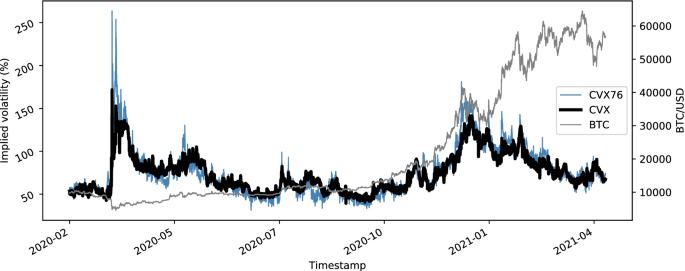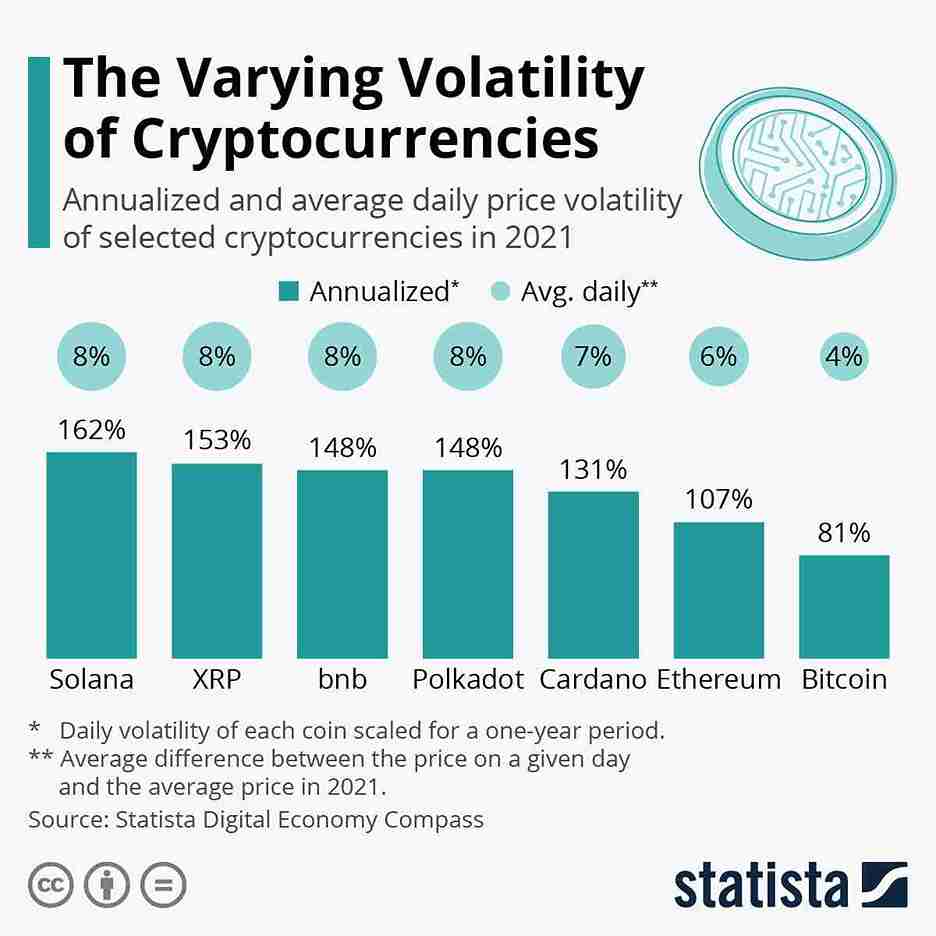A measure of an asset’s volatility in financial markets is the degree of price movement, either up or down. With the recent entry into the financial realm, the crypto market is a volatile asset class. Cryptocurrencies have the potential for higher returns and losses over a short period compared to other traditional asset classes. Therefore, it is generally considered a riskier investment than conventional assets like gold or stocks.
What drives the crypto market volatile is the critical question that needs to be answered. The main contributing factors include the market’s infancy, supply and demand dynamics, novice investors, speculative trading, and the industry’s murky regulatory environment.
Volatility in Financial Markets
Price volatility is not exclusive to the cryptocurrency markets. Traditional financial markets like the stock market have frequently seen high volatility. The stock market has a wide range of volatility, from often turbulent penny stocks to relatively stable blue chip or large-cap stocks like Apple or Berkshire Hathaway.
Scarcity drives value. Only 435 Days until the next #Bitcoin halving. pic.twitter.com/LtSlSQ0NAl
— Anup Dhungana (@CryptoAnup) January 7, 2023The dot-com bubble of the late 90s and early 2000s is one such example that illustrated high volatility in the stock market. During this period, the NASDAQ index, which comprises the most prominent technology firms, experienced sharp declines of over 75%. Many highly valued dot com stocks and companies like Pets.com even went out of business.
The crypto markets are exponentially more volatile than established financial markets. The first and largest cryptocurrency, Bitcoin, is widely regarded as comparatively less volatile than the myriad of altcoins in the market. However, when looking at bitcoin’s historical price charts, the level of volatility is in another league of its own.
Over its 14-year history, Bitcoin has experienced more than eight 50% corrections. However, each time a price decline occurred, it recovered to create a new record high.
The difference in levels of volatility is also demonstrated by the current downturn in both traditional financial markets and cryptocurrency prices. For instance, as of this writing, the price of the S&P 500 has dropped by almost 17% over the past year. The price of Bitcoin dropped by more than 60% during that time, and some promising altcoins, like Solana, saw drawdowns of more than 90%.
Factors that Influence Crypto Market Volatile
The bull and bear markets in cryptocurrencies are typically more extreme than other asset classes. In a short period, large price swings can result in significant gains or losses for investors. Read this article to learn more about crypto bull and bear markets.
While bull and bear markets are cyclical over a more extended period, short-term market corrections to the upside or downside are also more pronounced and volatile in the cryptocurrency market compared to other asset classes. It is not unusual for a crypto asset to increase or decrease in value by 30% in a single day.
Numerous factors that trigger price volatility in traditional markets also apply to crypto markets. For instance, geopolitical upheavals, wars, and pandemics cause price swings in crypto as in other markets. However, these events’ effects are frequently exaggerated in the crypto world. This is due to the fact that a variety of crypto-specific factors influence its volatility.
New and Emerging Market
Despite being around for over a decade, the crypto market is still a new asset class compared to established counterparts like the stock market or gold. At its peak, the overall crypto market cap reached $3 trillion, now valued at over $850 billion, according to CoinMarketCap. By comparison, the United States stock market is currently valued at $41 trillion, while the market cap of gold is at $12.38 trillion.
Due to the market’s relative size, smaller factors can have a more significant impact on price. For example, individuals who hold a sizable amount of crypto assets, also called “whales, ” could destabilize the crypto market if they decide to sell.
Supply and Demand

The law of supply and demand influences any financial asset’s price movement and volatility. However, in the crypto world, the distinctive supply dynamics of various cryptocurrencies frequently produce volatile conditions.
The finite and limited supply of certain crypto assets coupled with an increase or decrease in demand puts extra upward or downward pressure on prices. Bitcoin, for example, has a fixed supply of 21 million coins. This is why the bitcoin halving significantly impacts upward price action as the supply of bitcoin diminishes.
Volatility compounds when crypto “whales” buy or sell a particular asset in large quantities, potentially sending its price skyrocketing or plummeting. The crypto market cannot absorb these supply and demand shocks due to its relatively small size. Small-cap altcoins with a limited supply are particularly prone to extreme volatility by the supply and demand dynamics.
Sentiment and the Investor Profile
Crypto prices and investor sentiment are intrinsically linked. Retail investors dominate the investor profile that drives the cryptocurrency market. These investors tend to be novices with less financial knowledge or experience than traditional investors, making them more impressionable. This, along with the industry’s nascency, contributes to the exaggerated response to both good and bad news.
Bull markets and positive sentiment is often accompanied by FOMO (Fear Of Missing Out) among retail investors. This creates a positive feedback loop which leads to more FOMO. However, on the flip side, negative news quickly induces fear, causing prices to spiral down. Given how quickly sentiments can shift, investing with a FOMO mindset could result in enormous market losses. This article offers a helpful guide for those interested in learning how to combat FOMO while investing in cryptocurrencies. The often knee-jerk reaction and herd mentality among retail investors in the crypto market cause drastic price fluctuations.
Speculation
Retail investors come into the crypto markets with a high degree of speculation. As the potential for enormous profits is high, the volatility of the market itself lures individuals to place speculative bets. Volatility is a common byproduct of speculative investments because prices can swing sharply in both directions.
Investors place bets on an asset’s price going up by longing and on an asset price going down by shorting. The juxtaposition of these bets often leads to price fluctuations. Furthermore, leverage in the market exacerbates volatility.
Regulation
Unlike traditional financial markets, cryptocurrencies are yet to be fully recognized as an established asset class by regulatory bodies across the globe. This is due to their infancy as a sector and their disruptive potential. The lack of transparent and consistent regulation significantly impacts and makes crypto market volatile.
The absence of clear regulation enables projects and cryptocurrencies to list on exchanges without being subjected to maximum consumer protection, scrutiny, and risk mitigation. As a result, some cryptocurrency projects may end up being scams like Ponzi schemes that operate covertly before imploding. Negative news like scams harms investor sentiment, which in turn affects price movement.
Furthermore, without regulatory oversight, standard instruments found in traditional markets to mitigate risk and volatility, like circuit breakers, are non-existence in the crypto market.
Mitigating Risk against Crypto Volatility

The promise of significant returns can tempt investors to make rash speculative decisions when they first enter the crypto markets. However, neglecting proper risk management strategies runs the risk of considerable downside potential. The following are some risk management strategies to use when trading cryptocurrencies:
- Portfolio diversification: Investors can diversify their crypto assets rather than place their investment on a single cryptocurrency. Investors with a well-balanced portfolio will be less affected by fluctuations in the price of any one coin.
- Dollar Cost Averaging: Developing a patient strategy of dollar cost averaging is a tried and tested method of overcoming risk and volatility.
- Trading with Stop Loss and Take-Profit: Finally, learning about and using trading tools like Stop Loss (SL) and Take-Profit (TP) are effective ways to mitigate risk in the volatile crypto landscape.
Conclusion – Why is the Crypto Maket Volatile
So why is the Crypto Market Volatile?
Over its brief history, the price of cryptocurrencies has undergone enormous fluctuations. For investors, the volatility of cryptocurrencies offers both opportunities and challenges. As the industry continues to mature, as institutions begin to embrace the market, and as regulations take effect, the factors that currently influence price volatility could become irrelevant in the future. In the meantime, understanding these factors and learning to take the necessary risk management strategies will help investors make informed decisions while smoothly navigating through the volatility.



















